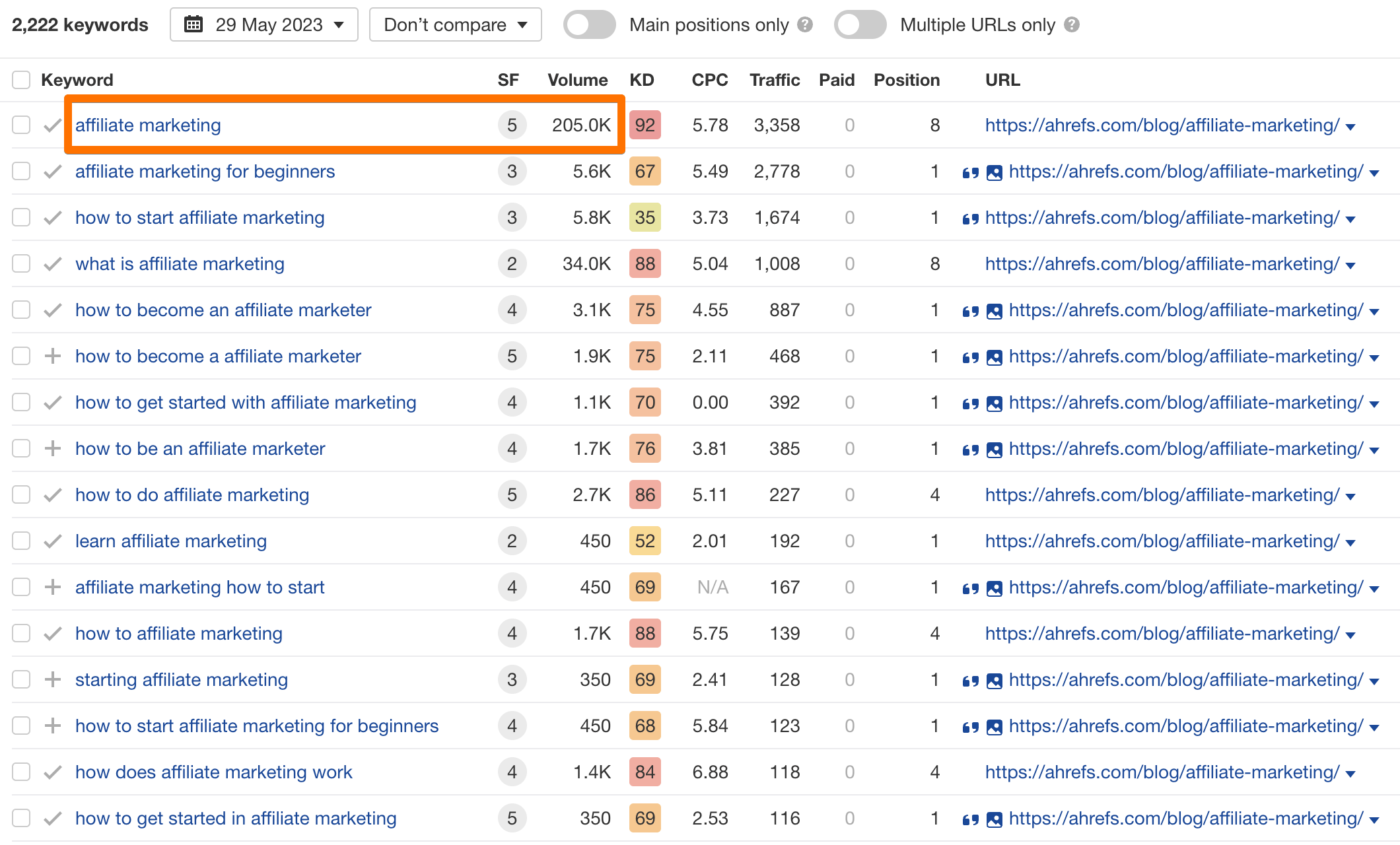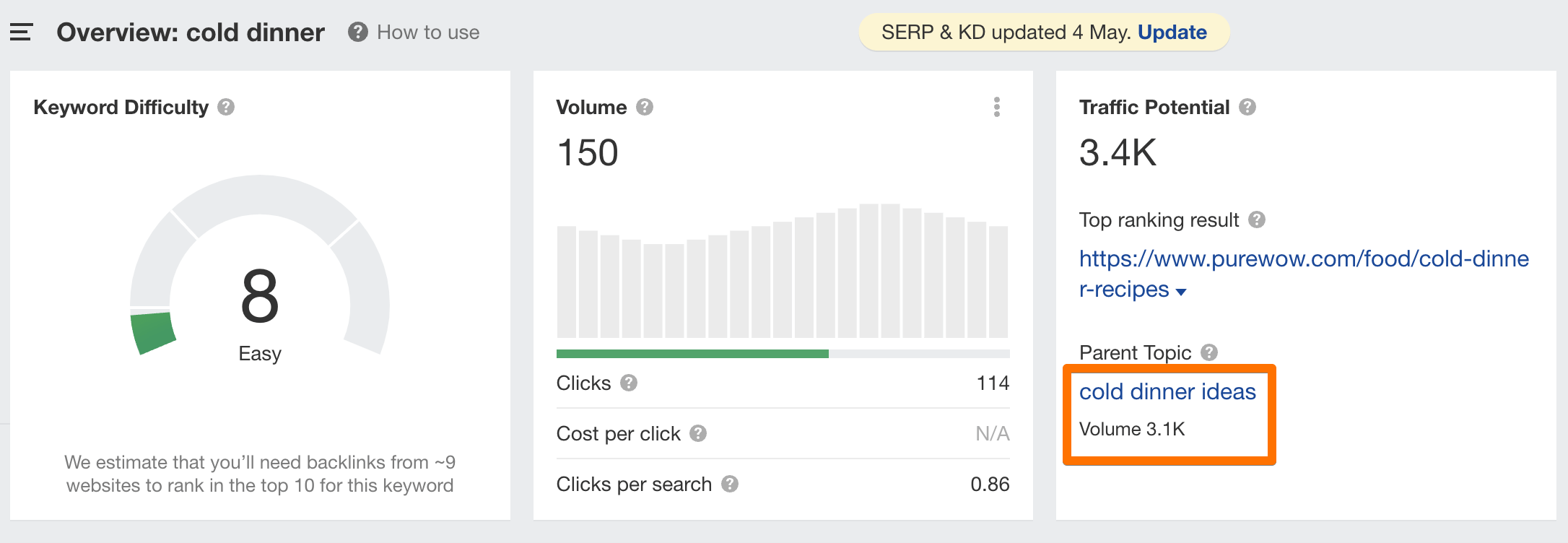Primary Keyword
What is a Primary Keyword?
A primary keyword, also known as a focus or main keyword, is the main term or phrase a webpage is expected to rank for in search engine results. In other words, a primary keyword is the main keyword a page is optimized for.
Typically, a primary keyword has a high search volume and can potentially bring a considerable amount of organic search traffic.
Secondary keywords, on the other hand, are words and phrases that fine-tune your content and add context, value, and depth. They’re more related to search intent, too.
While secondary keywords are typically less popular search terms, if used properly, they add value to and support the primary keyword. In simple terms, they complement each other.
Here’s an example from Ahrefs’ blog:

The primary keyword of the article is “affiliate marketing,” and the secondary keywords are “affiliate marketing for beginners,” “what is affiliate marketing,” “how to become an affiliate marketer,” etc.
Each secondary keyword has a lower search volume, but together they bring a considerable amount of organic search traffic to a page.
Why are primary keywords important?
Primary keywords are important because within a given “cluster” of keywords a page is targeting and could potentially rank for, those keywords have the highest search volume.
If you’re following SEO best practices, the primary keyword will be the main keyword the page is optimized for because it is the main topic you’re covering. It also gives search engines a clear signal about the topic of a page.
Also, the primary keyword typically serves as a seed keyword during keyword research.
How to find primary keywords?
To find primary keywords for your content, you need a professional SEO tool like Ahrefs. Here’s what you can do:
1. Reverse-engineer your competitors’ content
“Reverse-engineering” your competitors’ content is arguably the easiest way to find primary keywords worth targeting. Their top-performing pages can tell you a lot about the topics that resonate with your target audience - and keywords that could work for your website, too.
You’ll need a competitor research tool for that, such as Site Explorer.
A good starting point would be getting the list of organic keywords where your competitor or a relevant website is ranking on the 1st or 2nd page sorted by the Search Volume.

2. Using the “Parent topic” in Keywords Explorer
In SEO, a “parent topic” is typically defined as the overarching theme or category that a keyword falls under. This high-level “umbrella” keyword encompasses a range of other subtopics.
To identify the Parent Topic in Keywords Explorer, we take the page that ranks #1 for a keyword and look up for a more popular search query that it gets search traffic from.
Here’s an example:

This example shows that it’s not always wise to rely on your gut feeling when choosing the primary keyword. The keyword “cold dinner ideas” happens to have a much higher search volume than simply “cold dinner”.
How to target primary keywords?
Once you’ve identified the primary keyword, the next step is to optimize the page for it. This is where you need to know the basics of on-page SEO:
- Don’t overlook the importance of optimizing the URL of a page and including the primary keyword in it. The simple formula for this is www.domain.com/category/primary-keyword.
- The title tag is another important on-page element that should be optimized. Include your primary keyword somewhere in the title.
- The H1 tag should always include the primary keyword, preferably at the very beginning, within the first few words of the H1 tag.
- Make sure you use the target keyword in the first few sentences of your content or within the first paragraph, then include secondary keywords in your subheadings and body text.
Most importantly, though, make sure that you write content in a natural way, with human readers in mind. If the content is poorly written or otherwise unnatural, everything else you do in terms of SEO optimization will be in vain.
Naturally-written content can automatically rank for quite a few secondary keywords. But of course, it’s better to use a few in the subheaders of the page.
FAQs
What are secondary keywords?
Secondary keywords are words and phrases that are closely related to the primary keyword you are targeting with the page. Long-tail keywords, synonyms, and variations of the primary search terms can all be considered secondary keywords. Including these related (secondary) keywords supports the use of the primary keyword and ensures that you’re covering every major aspect of a given topic.
How many primary keywords can I target with one page?
You should generally aim to target one primary keyword per page. That way, you will only tackle one broad topic at a time. Then, to cover that topic in full and support your primary keyword, you should add enough secondary keywords in the body text and subheaders. When done right, this approach can help you to rank for tens - even hundreds - of other search queries.